List of McDonnell Douglas F-4 Phantom II variants

QF-4E Phantom II in flight at Holloman Air Force Base (November 2007)
The McDonnell Douglas F-4 Phantom II variants were numerous versions and designations of the F-4 and are described below.
Production numbers for major versions[]
| Aircraft | Number |
|---|---|
| F-4A | 45 |
| F-4B | 649 |
| RF-4B | 46 |
| F-4C | 583 |
| RF-4C | 503 |
| F-4D | 825 |
| F-4E | 1370 |
| F-4E 2020 (Turkey) | 54* |
| F-4EJ (Japan) | 140 |
| RF-4E | 149 |
| RF-4EJ (Japan) | 15* |
| F-4F | 175 |
| F-4G Wild Weasel | 134* |
| F-4J | 522 |
| F-4J (UK) | 15* |
| F-4K (UK) | 50 |
| F-4M (UK) | 116 |
| F-4N | 228* |
| F-4S | 302* |
asterisk indicates converted from other version
Variants[]

An XF4H-1 1959.

F-4Bs from VF-213, 1967.
- XF4H-1
- Two prototypes for the United States Navy, first flown 1958.
- F4H-1F (F-4A)
- Two-seat all-weather carrier-based fighter for the US Navy, J79-GE-2 and -2A engines with 16,100 lbf (71.6 kN) of afterburner thrust each. Named Phantom II in 1959 and redesignated F-4A in 1962; 45 built.[1]
- TF-4A
- A small number of F-4As converted into two-seat training aircraft.
- F4H-1 (F-4B)
- Two-seat all-weather carrier-based fighter and ground-attack aircraft for the US Navy and Marine Corps. J79-GE-8A or -8B engines with 16,950 lbf (75.4 kN) of afterburner thrust each. Redesignated F-4B in 1962; 649 built.[2]
- DF-4B
- F-4Bs converted into drone control aircraft.
- EF-4B
- One F-4B converted into an ECM training aircraft.
- NF-4B
- The redesignation of one F-4B for testing purposes.
- QF-4B
- F-4Bs converted into unmanned supersonic target drones; 25 converted.
- F4H-1P (RF-4B)
- Tactical reconnaissance version of F-4B for United States Marine Corps, nose stretched 4 ft 9 in (1.4 m), smaller AN/APQ-99 radar. Three camera bays typically carried KS-87 forward oblique/vertical camera on Station 1, KA-87 low-altitude camera on Station 2, and KA-55A or KA-91 high-altitude panoramic camera on Station 3. Also carried AN/APQ-102 reconnaissance SLAR, AN/AAD-4 infrared reconnaissance system, and ECM suite. The KS-72 or KS-85 cameras were on rotating mounts and could be aimed in flight which improved upon the earlier RF-4C which could only be aligned on the ground.[3] In 1975, modernized under Project SURE (Sensor Update and Refurbishment Effort); 46 built. Retired in 1990. 4 lost in Vietnam.[4] First flown 12 March 1965.[5]

An EF-4C in 1972.
- F-110A
- The original US Air Force designation for the F-4C.
- F-4C
- Two-seat all-weather tactical fighter, ground-attack version for the United States Air Force; supported a wide spectrum of weapons including AIM-4 Falcon, AGM-12 Bullpup, and nuclear weapons; wider main wheel tires resulted in distinctive wing bulges; J79-GE-15 engines with provision for cartridge start; boom refueling instead of Navy's probe and drogue refueling; AN/APQ-100 radar; duplicated flight controls in the rear cockpit. The aircraft exceeded Mach 2 during its first flight on 27 May 1963; 583 built.
- EF-4C Wild Weasel IV
- F-4Cs converted into Wild Weasel ECM aircraft. Equipped with , missile launch warning system, ECM receiver, and external ECM pod. Armed with AGM-45 Shrike anti-radiation missiles and cluster bombs but unable to carry the AGM-78 Standard ARM missile. A total of 36 were converted.[6] Many survivors were reverted to F-4C.
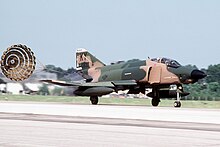
A Kentucky ANG RF-4C showing camera installations and drag chute.
- RF-4C
- All-weather tactical reconnaissance version for the US Air Force, AN/APQ-99 (later ) radar. Equipped similar to RF-4B but with a wider choice of camera fits, including a centerline pod for the gigantic (Long Range Oblique Photography) camera, capable of taking high-resolution images of objects 100 miles (160 km) away. Many aircraft were refitted with a more spacious bulging streamlined nose. A sub-variant, to be designated RF-4C(H) was proposed as a night "hunter" aircraft using infrared equipment instead of cameras under Operation Shed Light. In the end, none were converted. While usually unarmed, RF-4Cs retained the ability to carry a nuclear weapon on the centerline pylon. Additionally, the RF-4Cs of the Alabama, Nevada and RF-4 Fighter Weapons School were modified to carry the AIM-9 Air to Air Missile. These modernized RF-4Cs of the Alabama and Nevada Air National Guard extensively participated in the Gulf War; 503 built.
- Two RF-4Cs shot down by USSR during Project Dark Gene whilst being flown by USAF pilots.[7]
- YRF-110A (YRF-4C)
- Two prototypes were used in the development of the RF-4C reconnaissance version.
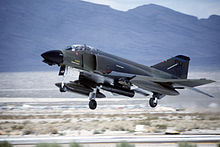
A 301st TFW F-4D, 1985.
- F-4D
- F-4C with updated avionics, AN/APQ-109 radar. First flight June 1965. One USAF pilot and two USAF WSOs became aces in F-4Ds; 825 built.[8]
- EF-4D Wild Weasel IV
- F-4Ds converted into Wild Weasel ECM aircraft. Unlike the EF-4C, the EF-4D had the capability to use the larger AGM-78 Standard ARM. Only 2 converted.[9]
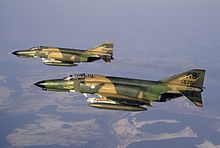
The F-4E introduced the integral 20 mm Vulcan cannon.
- F-4E
- USAF version with an integral M61 Vulcan cannon in the elongated RF-4C nose, AN/APQ-120 radar with smaller cross-section to accommodate the cannon, J79-GE-17 engines with 17,900 lbf (79.379 kN) of afterburner thrust each. Late-series aircraft equipped with leading-edge slats to improve maneuverability at the expense of top speed under the Agile Eagle program. Starting with Block 53, aircraft added AGM-65 Maverick capability and smokeless J79-GE-17C or -17E engines. First flight 1 August 1965. The most numerous Phantom variant; 1,370 built.
- F-4E Kurnass 2000
- Modernized Israeli F-4Es, AN/APG-76 radar, AGM-142 Popeye capability. Entered service in 1989, retired in 2004.
- F-4E Peace Icarus 2000 (UAP)

F-4E PI2000(UAP) departing the RIAT 2017 International Air Show, Fairford, UK.
- In 1998 the Hellenic Air Force decided, in collaboration with the German Aerospace Industry (DASA) and the Hellenic Aerospace Industry (HAI/EAB), to upgrade 39 F-4E Phantom II fighters. The first aircraft was delivered at Andravida Air Base in December 2002. All upgraded F-4s were equipped with the new AN/APQ-65YG radar similar to that of the F/A-18 Hornet, a new onboard Mission Control Computer (MCC), a Head Up Display, the IFF Interrogator, Multi Function Displays and were also capable of carrying a variety of advanced Air-to-Air and Air-to-Ground missiles. These included the AIM-120 AMRAAM (although only the -B edition), the AIM-9M missile, the AFDS and the entire family of the Paveway (I, II and III) laser-guided bombs. Although gradual retirement of F-4 units started in 2017, a number of aircraft are still operational in multi-role missions with the 338 Squadron ”Ares” and the 339 Squadron "Ajax” based in Andravida Air Force Base.[10] The F-4E Phantom II PI2000 (AUP) has also been certified for use of GBU-27 Paveway III laser-guided bombs.
- F-4E Terminator 2020

F-4E-2020 Terminator
- The latest in a long line of F-4 variants, the Terminators are a batch of Turkish Air Force F-4Es, modernized by Israel on the pattern of the Kurnass 2000. They differ from the existing F-4E airframe in a number of key areas, including new attachment fittings to better handle modern weaponry, stronger wing fold ribs, an updated canopy sill bar, and the replacement of some 20 km of wiring (reducing weight by 750 kg) as well as most hydraulic and pneumatic lines and hoses.[11] A plan to increase the turn-rate and longitudinal stability of the Kurnass/Terminator derivatives through the installation of fuselage strakes over the engine inlets was abandoned after testing, and never saw installation on operational aircraft. [12]
- The most radical changes occurred in the avionics department. All 2020s have been fitted with vastly updated suite, including MFDs (multifunction displays) as standard, and incorporating a number of new technologies, such as the new Kaiser El-OP 976 wide-angle HUD and HOTAS system, high performance Elta EL/M-2032 ISAR-capable high-resolution SAR/GMTI (ground moving target indicator) multi-mode fire control radar (developed for the IAI Lavi), IAIC mission computer, new navigation equipment including GPS/INS connected to mapping mode, dual MIL-STD-1553B databus managing avionics package, Astronautics Central Air Data Computer, new UHF and IFF packages, airborne video tape recorder (AVTR), Elta EL/L-8222 active ECM pod, Mikes (Aselsan) AN/ALQ-178V3 passive embedded SPEWS, and RWR.[11][13]
- Additionally, they received AGM-142 Popeye/Have Nap integration, Litening-II targeting pods, and the capability to launch AGM-65D/G Maverick, AGM-88 HARM, GBU-8 HOBOS, GBU-10/12 Paveway II LGBs, general purpose and cluster bombs for air-to-ground missions, while retaining the capability to launch AIM-7 Sparrow and AIM-9 Sidewinder air-to-air missiles. It is also possible to install Pave Spike targeting pods and rocket pods of all sizes.[11][13]
- These upgraded F-4 Phantoms are referred to as the F-4E-2020 Terminator. 54 were modernized and they will be in service until at least 2015 and perhaps longer (29 still in use as of 2019.) They first entered service on 27 January 2000 with deliveries to 111 and 171 Filo.[14]
- QF-4E
- Remote-controlled target drone.
- F-4EJ

A Japanese Mitsubishi F-4EJ
- Two-seat all-weather air defense fighter version of F-4E, initially lacked ground attack capability. Built under licence in Japan, by Mitsubishi Heavy Industries for the Japan Air Self-Defense Force; 140 built (138 by Mitsubishi).
- F-4EJ Kai
- Upgraded version of the F-4EJ with improved avionics, including AN/APG-66J pulse-doppler radar, and ground attack capability, including ASM-1 anti-ship missile.
- EF-4EJ
- Small number of F-4EJs were converted into ECM training aircraft.
- F-4E(S)
- Three Israeli F-4E modified for high-speed reconnaissance as a cheaper alternative to the ambitious F-4X. Fitted with a new nose containing the HIAC-1 LOROP long-range camera with a 66-in (168 cm) focal length as well as a vertical KS-87 camera. The aircraft had a false radome painted on the nose to resemble conventional F-4Es. The fate and service record of these aircraft is unknown.[15]
- RF-4E

A RF-4EJ operated by the Japan Air Self-Defence Force
- Unarmed reconnaissance version for export only. Retrofitted to carry weapons by most customers. Several German Air Force aircraft were modified for ELINT missions under Peace Trout program; 149 built.
- RF-4EJ
- Modified Japanese F-4EJ to operate reconnaissance equipment. Unlike RF-4E, M61 Vulcan is mounted in the nose. 15 converted.

The YF-4E
- YF-4E
- One of the original YRF-4C prototypes was converted into the YF-4E. The YF-4E was used in the development of the F-4E fighter as well as in fly-by-wire (PACT) and (CCV) test programs. Three conversions.
- F-4F
- F-4E for German Air Force with simplified equipment, no Sparrow capability; 175 built.
- F-4F ICE
- (Improved Combat Efficiency) Upgraded F-4F with AN/APG-65 radar and AIM-120 AMRAAM capability.
- TF-4F
- German trainer aircraft, with pilot instructor aft station and appropriate controls.
- F-4G
- US Navy version, 12 F-4Bs were fitted with the AN/ASW-21 data link digital communications system for automatic carrier landings, one shot down by enemy ground fire, the surviving 11 returned to F-4B configuration.[16]

An F-4G Wild Weasel V.
- F-4G Wild Weasel V
- F-4E converted to SEAD aircraft for the US Air Force. AN/APQ-120 radar, their cannon replaced by the APR-38 RHAW[17] and later the AN/APR-47,[18] several ECM pods including the ALQ-87, ALQ-101, ALQ-119, ALQ-130, ALQ-131, and the ALQ-140 IR jammer, the ability to carry AGM-45 Shrike, AGM-78 Standard, and AGM-88 HARM anti-radiation missiles. Widely used during the Gulf War, Operation Provide Comfort, and Operation Southern Watch; 116 converted initially, with a further 18 F-4E's converted as attrition replacements for a total of 134.
- QF-4G
- Remote-controlled target drone.
- F-4H
- Designation not used to avoid confusion with the pre-1962 F4H.[19]

A U.S. Navy F-4J, 1971.
- F-4J
- Improved F-4B version for US Navy and Marine Corps, with emphasis on air-to-air combat capability improvement, which include: J79-GE-10 engines with 17,844 lbf (79.374 kN) of afterburner thrust each, AN/APG-59 pulse doppler radar coupled with the AN/AWG-10 Fire Control System for look-down shoot-down capability, larger main landing gear wheels resulting in wing bulges similar to F-4C, slatted tailplane, ailerons drooped 16.5° when landing gear and flaps were deployed to decrease the landing speed, zero-zero ejection seats, expanded ground attack capability, no IRST sensor under the nose; One USN pilot and one USN Naval Flight Officer became aces in F-4Js. First flight May 1966; 522 built.
- F-4J(UK)
- Designation of 15 low airtime F-4J aircraft purchased by the Royal Air Force from the US Navy in 1984, upgraded to F-4S standard with some British equipment. Referred to in the UK as F-4J(UK) rather than F.3 to avoid confusion with the Tornado F.3 that was in service at the same time.[citation needed] Used until 1991 by No. 74 Squadron RAF only for UK air defense in lieu of Phantoms sent to Falklands.
- DF-4J
- One F-4J converted into a drone control aircraft.
- EF-4J
- Two F-4Js converted into ECM training aircraft.
- YF-4J
- Three F-4Bs were converted into YF-4J prototypes. The YF-4Js were used in the development of the F-4J.

- F-4K
- F-4J version for Fleet Air Arm of the Royal Navy to replace the De Havilland Sea Vixen.[20] Operated as the Phantom FG.1 (Fighter/Ground attack). Folding nose and extending nosewheel leg. Re-engined with the more powerful British Rolls-Royce Spey 202 turbofan engines which required an enlarged fuselage but gave more power taking off from smaller carriers and was already in use with Blackburn Buccaneer on RN carriers. Delivered from 1968, with cancellation of planned carriers order cut and 20 diverted to the Royal Air Force before going into service; 50 built. RN aircraft withdrawn by 1978 and passed to RAF.
- YF-4K
- Two prototypes, used in the development of the F-4K.
- F-4L
- Designation applied to several proposals for an advanced version, including Model 98FOA with RR Spey turbofan engines and AIM-54 Phoenix missiles.
- F-4M
- Tactical fighter, ground-attack, and reconnaissance aircraft developed from F-4K for the Royal Air Force, UK designation Phantom FGR.2, ordered after cancellation of the Hawker Siddeley P.1154 supersonic V/STOL aircraft. RR Spey turbofan engines; 116 built. Replaced English Electric Canberra and Hawker Hunter. Replaced in turn by SEPECAT Jaguar in ground-attack mission; replaced English Electric Lightning in air defense role.
- YF-4M
- Two prototypes used in the development of the F-4M.

A U.S. Marine Corps F-4N aboard Coral Sea, 1980.
- F-4N
- F-4B modernized under project Bee Line, the same aerodynamic improvements as F-4J, smokeless engines. First flight 4 June 1972; 228 converted.
- QF-4N
- F-4Ns converted into remote-controlled supersonic target drones.
- F-4S
- F-4J modernized with smokeless engines, reinforced airframe, leading-edge slats for improved maneuverability. First flight July 1977; 302 converted.
- QF-4S
- F-4S converted into supersonic target drones.
- F-4E/TM Şimşek (Lightning)
- One of the latest modernised variants of F-4E. Modernised by ASELSAN for the Turkish Air Force.
- RF-4E/TM Işık (Light)
- One of the latest modernised variants RF-4E. Modernised by ASELSAN for the Turkish Air Force.
Proposals[]
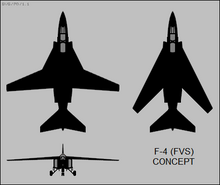
Variable Geometry Phantom proposal
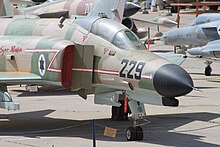
4X-JPA, the Super Phantom prototype, on display at the Israeli Air Force Museum
- F-4E(F)
- Proposed single-seat simplified version of F-4E for the German Air Force; none built.
- RF-4M
- Proposed, dedicated reconnaissance variant of the F-4M for the RAF; intention to fit equipment internally rather than through carriage of external reconnaissance pod. Not proceeded with.[21]
- F-4T
- Proposed air superiority-only fighter version; none built.
- F-4 (FVS)
- Proposed version with variable geometry wings; none built.
- F-4X
- Proposed high-performance reconnaissance version with HIAC-1 LOROP camera for Israel developed under the Peace Jack program in conjunction with General Dynamics. Water injection was projected to give the aircraft a top speed in excess of Mach 3 (over 2,000 mph (3,200 km/h) at high altitudes). The water would be contained in a pair of 2,500 US gal (9,600 L) conformal tanks on the sides of the fuselage spine. The US State Department became worried about developing an aircraft with performance similar to the SR-71 Blackbird and offensive capability beyond anything in domestic inventory for a foreign customer and forbade its export. The proposal was then modified to the RF-4X standard with the camera in the nose and removal of weapon carriage. However, the US Air Force withdrew from the project over concerns that a high-performance Phantom would jeopardize funding for the anticipated McDonnell Douglas F-15 Eagle. Without United States financial support, Israel settled for the simpler, less expensive F-4E(S), which was given the nickname 'Shablool', or 'Snail'.[15]
- Boeing Super Phantom
- A 1984 joint venture between Boeing and Pratt & Whitney for a Phantom variant with Pratt & Whitney PW1120 turbofan engines, giving a significant performance gain over J79 Phantoms. The aircraft would also have an 1,100 US gal (4,230 L) conformal fuel tank under the fuselage.[22] Cancelled early in development.[23]
- IAI Super Phantom
- A separate Israel Aircraft Industries project was proposed for a PW1120-powered Phantom,[24] and one prototype built.[25] IAI's F-4 "Super Phantom" or F-4-2000, which could exceed Mach 1 without afterburners, was displayed at the 1987 Paris Air Show. McDonnell Douglas scuttled the F-4-2000's development because it equaled the F/A-18C/D in performance and could endanger future F/A-18 sales[citation needed].
See also[]
- McDonnell Douglas F-4 Phantom II
- F-4 Phantom II non-U.S. operators
- F-4 Phantom II U.S. operators
References[]
Notes[]
Citations[]
- ^ Francillon 1979, p.559.
- ^ Francillon 1979, pp.559-560.
- ^ Sweetman 1987, p. 531.
- ^ Dorr 1987, p. 39.
- ^ Eden 2004, p. 278.
- ^ Francillon Air International July 1994, pp. 15–17, 20.
- ^ "Project Ibex and Project Dark Gene". www.spyflight.co.uk. Archived from the original on 2015-09-24. Retrieved 2012-06-30.
- ^ Dorr and Donald p.194.
- ^ Francillon Air International July 1994, p.17.
- ^ "338 Μοίρα Δίωξης – Βομβαρδισμού;". Haf.gr. Archived from the original on March 1, 2009. Retrieved July 29, 2009.
- ^ Jump up to: a b c F-4 Phantom on the "warriorsoul" Archived 2008-02-29 at the Wayback Machine, Turkish Armed Forces website, Retrieved: 8 February 2008
- ^ Klein and Aloni, Andreas and Schlomo (2009). The 'Kurnass' in IDF/AF Service 1989 until Today. Double Ugly Books.
- ^ Jump up to: a b Donald and Lake 1996
- ^ Phantom for Turkey Archived 2008-05-02 at the Wayback Machine, J Baugher, May 20, 2000.
- ^ Jump up to: a b Miller 1985, pp.19-25.
- ^ Francillon Air International July 1994, pp. 17–20.
- ^ "Archived copy". Archived from the original on 2013-10-21. Retrieved 2015-04-04.CS1 maint: archived copy as title (link)
- ^ "Archived copy". Archived from the original on 2014-01-02. Retrieved 2014-05-10.CS1 maint: archived copy as title (link)
- ^ Francllion 1979, p.568.
- ^ "The Royal Air Force - History Section". Archived from the original on 2007-11-22. Retrieved 2007-09-21.
- ^ Simmelink, Kim (20 November 2013). "Phantoms that never were built… RF-4M". Phantom Phacts. Retrieved 9 June 2016.
- ^ Spick 1985, pp. 289-90.
- ^ "Boeing "Super Phantom"". July 25, 2008. Archived from the original on July 25, 2008.
- ^ Spick 1985, pp. 290-291.
- ^ "[3.0] Phantom In Foreign Service". www.faqs.org.
Bibliography[]
- Baugher, J "McDonnell F-4 Phantom II", American Military Aircraft
- Donald, David and Lake Jon, eds. Encyclopedia of World Military Aircraft. London: AIRtime Publishing, 1996. ISBN 1-880588-24-2.
- Dorr, Robert J. and Donald, David. Fighters of the United States Air Force. London:Temple Press/Aerospace, 1990, ISBN 0-600-55094-X.
- Dorr, Robert F. Phantoms Forever. London: Osprey Publishing Limited, 1987. ISBN 0-85045-742-4
- Eden, Paul ed. The Encyclopedia of Modern Military Aircraft. London: Amber Books Ltd, 2004. ISBN 1-904687-84-9
- Francillon, René J. McDonnell Douglas Aircraft since 1920. London:Putnam, 1979. ISBN 0-370-00050-1.
- Francillon, René J. ""Wild Weasel Phantoms". Air International, July 1994, Volume 47 No 1. Stamford, UK: Key Publishing. pp. 15–21.
- Miller, Jay. "Peace Jack: An Enigma Exposed". Air International, July 1985, Volume 29, No. 1. Bromley, UK: Fine Scroll. pp. 18–23.
- Spick, Mike. "2001 Phantom Odyssey". Air International. December 1985, Volume 29, No. 6.Bromley, UK: Fine Scroll. pp. 287–292.
- Sweetman, Bill and Bonds, Ray. The Great Book of Modern Warplanes. New York, New York: Crown Publishers, 1987. ISBN 0-517-63367-1
Categories:
- McDonnell Douglas F-4 Phantom II
- Lists of aircraft variants